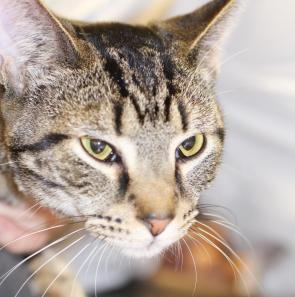Cats and Hairballs: What are they and What Can we do to Stop Them?
- posted: May 31, 2019

We all know cats vomit from time to time—usually on the white rug or maybe on someone’s shoes. Vomiting can be caused by any number of medical problems, but one common issue in our feline friends is hairballs.
What causes hairballs? A hairball can form in a cat’s stomach if he or she is ingesting large amounts of hair due to normal grooming behavior. When a cat licks her coat, barbs on her tongue catch loose hairs and the cat swallows this hair. Most of the ingested hair passes through the intestinal tract with no problem. But, if a large amount of hair is swallowed, it can form a mat in the stomach causing irritation to the stomach and forcing the cat to throw up the hair. The vomited hair often looks like a tube or cigar due to passing through the cat’s esophagus. Cats may cough and retch for some time before bringing up a hairball. Long-haired cats tend to have more problems with hairballs forming than short-haired cats, but excessive shedding or grooming can lead to hairball formation in any feline.
What can I do to prevent hairballs? Keeping your cat groomed by combing or brushing him will remove excess loose hair from the coat to prevent it from being removed by the cat and swallowed. Having long-haired cats’ coats professionally clipped or shaved will also help reduce hairballs. If your cat seems to have a very thin coat or is observed to be excessively grooming or pulling out tufts of fur, consult your vet. Allergies or other skin or medical problems may cause over-grooming and could increase the number of hairballs your cat forms. There are also commercially available hairball foods, treats and pastes that act as mild laxatives and contain either fiber and/or petroleum jelly. They help lubricate the hair to move it through the cat’s intestines instead of hanging out in his stomach where it is more likely to be vomited up.
What if it’s not a hairball? Coughing and vomiting can be caused by medical conditions other than hairballs. If your cat coughs frequently and sounds like she is going to bring up a hairball, but never actually brings anything up, she may have feline asthma. The hoarse, dry cough of an asthmatic cat often sounds similar to that of a cat with a hairball. If your cat vomits frequently (more than three times a month), is lethargic, is not eating, or has changes in bowel habits (diarrhea or constipation), he probably does not have hairballs. Have your cat checked by your vet if he or she has frequent vomiting or any of the other signs described as your cat may have an intestinal obstruction or a medical condition like inflammatory bowel disease, hyperthyroidism or another illness causing vomiting. Occasionally, a hairball can become so large that it causes a blockage. This is rare, but can be a life-threatening problem, and the hairball may need to be surgically removed.
So, while hairballs are a natural, if sometimes nasty, part of owning a cat, excessive vomiting of hairballs might indicate a problem. Keep your kitty groomed, try cat laxative products to help hair move though your cat’s intestines and check in with your vet if kitty is vomiting hairballs more than a few times a month. Fewer hairballs means less cleanup and fewer chances of stepping on that sausage-shaped pile of hair your cat left next to your bed in the middle of the night!
This blog brought to you by the Patton Veterinary Hospital serving Red Lion, York and the surrounding communities.
https://pets.webmd.com/cats/guide/what-to-do-about-hairballs-in-cats#2
Location
Patton Veterinary Hospital
425 E Broadway
Red Lion, PA 17356
